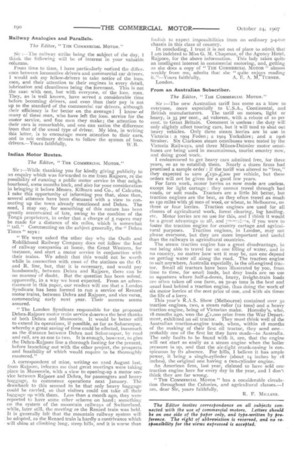From an Australian Subscriber.
Page 22

If you've noticed an error in this article please click here to report it so we can fix it.
The Editor, "THE COMMERCIAL MOTOR."
Sir :—The new Australian tariff has come as a blow to everyone, more especially to U.S.A., Continental, and British manufacturers. The tariff on motors, light or heavy, is 35 per cent., ad valorem, with a rebate of to per cent. to Great Britain. Comment is useless : the duty will only slightly affect touring cars, but it will tend to shut out heavy vehicles. Only three steam lorries are in use in Victoria a 1934 Foden; a 1e04 Yorkshire; and a 1906 Straker. Six Clarkson steam omnibuses were tested by the Victoria Railways, and three Milnes-Daimler motor omnibuses are being used in mountainous, tourist country now, and doing good work.
I endeavoured to get heavy cars admitted free, for three years, so as to establish them. Nearly a dozen firms had promised a sample order : if the tariff was altered to "free," they expected to save 4.x50-4.2oo per vehicle, but these orders will not be given for a good few years.
For farm work, motor lorries as now made are useless, except for light cartage : they cannot travel through bad roads, or soft roads. Tractors are a little bit better, but traction engines are the best, as they often travel as much as Iso miles with 36 tons of wool, or wheat, to Melbourne, on three or four lorries. Traction engines are used for all classes of agricultural work, forest clearing, log hauling, etc. Motor lorries are no use for this, and I think it would he a great advantage to all, and :.ereeolees, if you were to foster the traction engine for country cartage and agricul tural purposes. Traction engines, in London, may not please everyone, but they are more important and useful than the railways in agricultural countries.
The steam traction engine has a great disadvantage, in riot being able to travel far on one filling of water, and in no country, no matter how wet it may be, can one depend on getting water all along the road. The traction engine to suit anywhere, Australia especially, is the oil-engined tractor. Small oil tractors have been illustrated by you, from time to time, for small loads, but dray loads are no use to squatters where half-a-dozen, heavy, freight-train loads are often taken off one farm, as 30-40 tons is the best and usual load behind a traction engine, thus doing the work of six motor lorries at the cost price of one, and with six times the life of a lorry.
This year's R.A.S. Show (Melbourne) contained over 30 traction engines, two, a steam roller (12 tons) and a heavy traction engine, being of Victorian make. Hornsby's, who, t8 months ago, won the £i,000 prize from the War Department, exhibited an oil tractor. They must think well of the Australian traction-engine trade, when, within t8 months of the making of their first oil tractor, they send one— probably one of the first lot they have made—to Australia. The only faults to be found with it, are, that the engine will not start as easily as a steam engine when the boiler pressure is up, and that the air-tight crank-casing is conspicuous by its absence. For hills, I believe it has ample power, it being a single-cylinder (about 14 inches by 18 inches), the original one having a two-cylinder engine.
An American firm, last year, claimed to have sold one traction engine here for every day in the year, and I don't think they are far wrong. "THE COMMERCIAL MOTOR" has a considerable circulation throughout the Colonies, and agricultural classes.—I am, dear Sir, yours faithfully,
R. F. IV LANE.


























